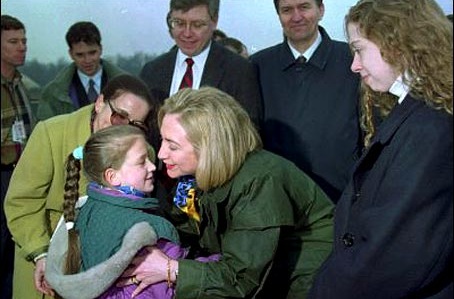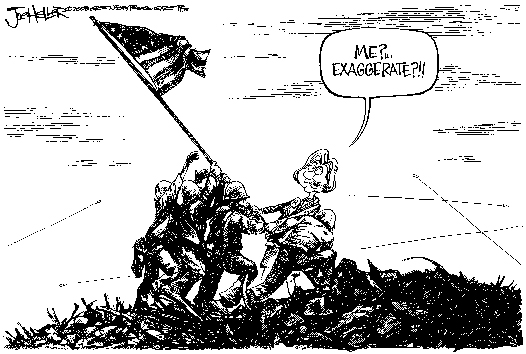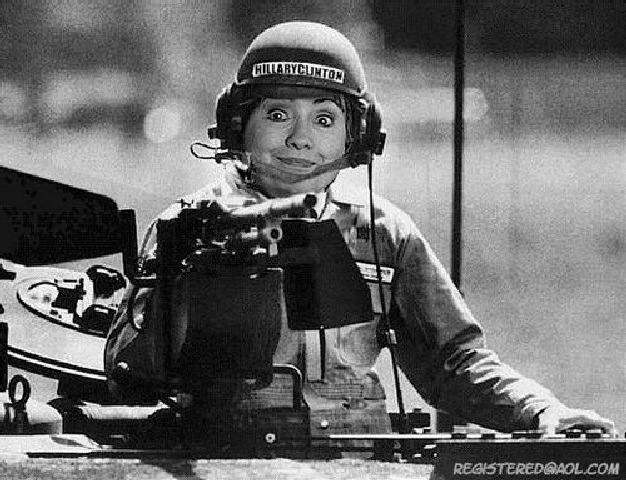The story of Hillary Clinton’s compulsive lying about being under sniper fire during a trip to Bosnia is already slipping away, so much so that she now is referring to is as a minor mistake. Well, I guess we should forgive and forget, right? (Wrong.) Before that happens, however, let’s take one last look at Hillary dodging bullets as she sprints across the tarmac:
As one astute reader put it at another blog, it depends on what your definition of “sniper fire” is.
Cynics will be gloating over this egregious example of how “all politicians lie.” That sloppy thinking only helps cynics and liars. Not everyone is in Hillary’s league, and she, not her opponent, has asked that people judge her on her judgment and experience. Note that character is not on that list, and the lie about her reception upon landing in Tuzla reflects both bad judgment and a misuse of experience. But, truth be told, her claim may have been not so much a lie in her own sense of things as a fiction–something not true that is told to convey a truth. OK, the snipers weren’t there, and she had to know it since she brought her daughter along, but you’ve just got to know that she is soooo ready to be a “war-time president.”
I don’t think earnest yearning excuses much, but if we grant Hillary any slack, she had better be ready to concede that visual commentary might tell the story slant to get a better sense of the truth. Like this:
Editorial cartoonists love to use the Iwo Jima icon. This one may seem a tad unfair because of how the icon is gendered, but, again, it’s Hillary who has said she’s the only one who ought to answer the mythical National Security Phone. What is more telling is that she is facing the viewer. In contrast to the anonymity of the soldiers laboring together selflessly on behalf of the nation, she is jumping in unbidden to serve personal ambition. Of course, she wasn’t claiming to be a soldier, and there are no bullets in the iconic photograph of the flag-raising, but the cartoonist has revealed more than one problem with Clinton’s lie.
Hillary got caught telling a whopper; perhaps she ought to be given a dose of her own medicine. Some people wish it could be her Dukakis moment–that is, the equivalent of the 1988 Democratic candidate’s mistaken photo-op, when a shot of him riding in a tank became a defining moment of the campaign and one reason you don’t hear references to “President Dukakis.” That episode may be why you can see this image online today:
Really, really unfair. I’m just broken up about it.
Photograph by the Associated Press. Cartoon by Joe Heller/Green Bay Press-Gazette (March 31, 2008). Photoshopped image by registered@aol.com. For scholarly discussion and examples of the use of the Iwo Jima template in editorial cartooning, see Janis L. Edwards and Carol K. Winkler, “Representative Form and the Visual Ideograph: The Iwo Jima Image in Editorial Cartoons,” Quarterly Journal of Speech 83 (1997(: 269-89, and Hariman and Lucaites, No Caption Needed, at pp. 121-124 (on Iwo Jima) and elsewhere.



Actually, the photograph may be “lying” here as much as people think Hillary was. As I understand it, the official welcoming ceremony was canceled or moved indoors due to fears of/cautions about gunfire. The little girl somehow became an unofficial welcoming moment, but not part of any official ceremony.
I realize that HC herself may have told this version, but I also heard a third party state that the members of Hillary’s group were required to have their flack jacket-type protectors in place as a cautionary measure. If true, then the dust-up on “HIllary’s lies” is indeed simplistic and overstated as is the common interpretation of the photo. Similarly, the new attack is on Hillary’s repitition of someone else’s experiential lore, which exposes a larger truth about our health care system, even though the details seemd to be lacking. Can photos “lie”? One test I teach my students is the issue of motive and intention at play. Apparantly, we are loathe to make the same considerations about verbal expressions.
Thanks for the mention, but in case anyone wants to actually look up the sources, Janis L. Edwards and Carol K. Winkler are the authors of the QJS essay on the Iwo Jima image.
Sorry about that; I’ve corrected the citation in the post.